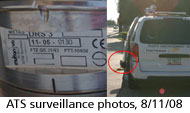Article from: www.thenewspaper.com/news/25/2502.asp
8/14/2008
Redflex Accused of FCC Violations
Redflex may have violated federal regulations by using uncertified photo radar devices. Arizona DPS orders Redflex vans off the streets.
 The Federal Communications Commission (FCC) is looking at potential violations of federal regulations by Redflex, an Australian company that operates mobile speed cameras in Arizona, Colorado, Louisiana, Ohio, Oregon and Washington. This week, the Arizona Department of Public Safety took the allegations seriously enough to order Redflex vans off of state highways. It is unclear whether other local and state agencies will follow suit.
The Federal Communications Commission (FCC) is looking at potential violations of federal regulations by Redflex, an Australian company that operates mobile speed cameras in Arizona, Colorado, Louisiana, Ohio, Oregon and Washington. This week, the Arizona Department of Public Safety took the allegations seriously enough to order Redflex vans off of state highways. It is unclear whether other local and state agencies will follow suit.
Redflex rival American Traffic Solutions (ATS) carefully documented the potential violation and last week fired off a 31-page complaint to the FCC. ATS followed up on Tuesday with a 20-page letter that included surveillance photographs documenting the alleged use of uncertified equipment by Redflex in violation of federal law.
"Redflex is marketing and operating the DRS-3 radar in the United States, without FCC certification and without any labels or markings showing an FCC ID," ATS Vice President Philip Underhill wrote in a letter to the FCC's Office of Engineering and Technology. "These radar units transmit and receive radio waves in a bandwidth that is specifically regulated by the Federal Communications Commission. Such a 'Radiolocation Transmitter Device,' (also known as a traffic speed radar system) cannot be marketed for sale, sold or used in the United States without being Type Accepted by the FCC."
Industrial and consumer electronic equipment that transmits or receives radio waves must meet federal technical standards designed to ensure that devices do not interfere with television and radio reception or with critical public safety systems such as air traffic control and police radios. The FCC maintains a lab in Maryland equipped with an anechoic chamber so that such devices can undergo scientific testing. Those that pass the test are granted an FCC ID number and can display an FCC certification logo. The FCC also allows testing in approved, private labs, including one located in New South Wales, Australia.
After ATS noticed that its Australian rival had ignored these requirements for the German DRS-3 and British AGD-340 radar components installed in its photo radar vans, ATS decided to bring the violation to the attention of federal regulators. No listing for these radar units or Redflex was found in a search of FCC records.
"This letter is a formal complaint and request the FCC intercede and require Redflex to stop marketing, selling and using the DRS-3 radar antenna until such time as Type Acceptance is granted by the FCC," Underhill wrote. "We also request that the FCC enforce any penalties that may be due as a result of potentially illegal actions and use."
Underhill suggested that the failure of Redflex to file FCC Form 740 before using the device is punishable by a maxmimum penalty of $250,000 and five years in jail. If the FCC determines that a violation took place, it would not be the first time that the Australian company has been found guilty of ignoring US law. In July, the Arizona Secretary of State found that the notary public employed by Redflex falsified documents used to certify speed camera deployments in Lafayette, Louisiana. The ATS filing with the FCC cited the falsified documents which confirmed the use of a radar that is not certified for use in the United States.
A copy of the ATS letter sent to the FCC on Tuesday is available in a 65k PDF file at the source link below.
Source: Use and Sale of the Multanova DRS-3 Non-Type Accepted Radiolocation Transmitter (American Traffic Solutions, 8/12/2008)
Permanent Link for this item
Return to Front Page
 The Federal Communications Commission (FCC) is looking at potential violations of federal regulations by Redflex, an Australian company that operates mobile speed cameras in Arizona, Colorado, Louisiana, Ohio, Oregon and Washington. This week, the Arizona Department of Public Safety took the allegations seriously enough to order Redflex vans off of state highways. It is unclear whether other local and state agencies will follow suit.
The Federal Communications Commission (FCC) is looking at potential violations of federal regulations by Redflex, an Australian company that operates mobile speed cameras in Arizona, Colorado, Louisiana, Ohio, Oregon and Washington. This week, the Arizona Department of Public Safety took the allegations seriously enough to order Redflex vans off of state highways. It is unclear whether other local and state agencies will follow suit.